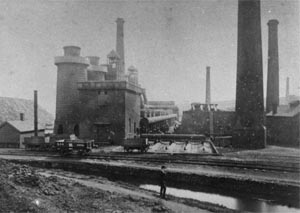
|
THE PRODUCTION OF METAL The metal industry Staffordshire was dominated by the production of iron in the south of the county, “the Black Country”. There was a large supply of ironstone, and the furnaces were easily fuelled by the coal or coke also found in abundance there. But there were also ironworks in operation in north Staffordshire near the coal mines, such as at Silverdale near Newcastle-under-Lyme. From the time of the industrial revolution, these would have been steam-furnaces which used an engine, and a good water supply would have been essential. Very often the iron furnaces would be on the same site as the coal mine, with minimal distances to get the fuel to the furnaces, and with shared transport links for the coal and iron that was being sent out. The furnaces had to be very sturdy buildings with think walls, often reinforced with iron, to withstand the heat, and they were designed around the required structure of the steam-engines and other machinery. Detailed description of the processes involved, and a schedule of buildings and machinery are shown in this selection of documents, both of which give an indication of what work was being carried out. Related to the iron trade, tin plate was also produced in the county. These were thin rolled or beaten sheets of iron that were coated with tin to prevent corrosion. These sheets could then be sold on to manufacturers of finished products. An early tin plate manufactury was located in Oakamoor in the southern Moorlands in the 18th century where there were small-scale works for iron and other metals. The manufacturer illustrated in this series was located in Kings Bromley on the canal system so having good transport connections. In the north of the county, there were also copper and brass works, the metal ore being produced from mines in the Staffordshire Moorlands. For related documents see the section on mines and quarrying. There were mills in which the metal was smelted from the stone, and then rolled. The major manufacturer had sites in Cheadle, Alton and Oakamoor, the latter locations being in the Churnet Valley and so having good water power from the river as it passed through the narrow gorges. |
